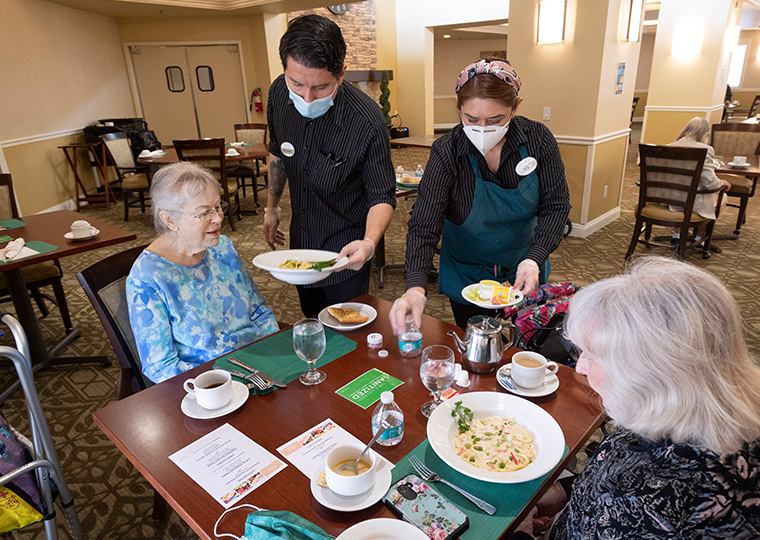Hint: Not the pharmaceutical companies that developed them
In March 2020, the outbreak of a very contagious, often deadly disease sent scientists scrambling to find effective, affordable treatments for COVID-19. It was a tall order, considering no one had seen this virus before, much less identified promising drug formulas that might protect human health against its destructiveness.
The traditional path to U.S. drug development clearly wouldn’t do. Pharmaceutical companies spend, on average, about 10 years of testing and hundreds of millions, if not billions, of investment dollars to bring each new drug to market. Some 90% of these trials fail to achieve Food and Drug Administration approval necessary for prescribing.
Opt In to the Review Monthly Email Update.
The fastest way to get treatments out would be to find COVID-19 fighters among the drugs already FDA-approved for some other condition. Having been deemed safe by testing and time in public use, FDA-approved drugs can be prescribed off-label for any use a physician sees fit. From a health policy perspective, drugs old enough to have generic competition were a particularly attractive subset for repurposing efforts because they are vastly cheaper than brand-only versions. (Drug developers lose exclusivity rights to a formula 20 years after a patent is granted.)
Research published in Health Affairs looks at data from clinical trials during the first two years of pandemic to understand what motivates researchers to revisit already-approved drugs for potential repurposing. Harvard’s Wesley Greenblatt and UCLA Anderson’s Charu Gupta, a postdoctoral scholar, and Jennifer Kao examine characteristics of previously approved drugs that came under review — the types of problems they originally treated and their patent statuses — as well as what type of institutions sponsored the trials.
These trials uncovered numerous approved drugs that were quickly repurposed to fight COVID, according to the findings. Yet the pharmaceutical companies that originally patented the drugs “played a limited role in supporting drug repurposing,” the authors write. “Instead, most sponsorship for clinical trials of repurposed drugs came from academic institutions, especially for drugs with generic competitors already on the market.”
It’s money, of course, that skews industry attention toward developing new drugs rather than repurposing old ones. Two decades of monopoly profits for novel formulas is a strong motivator for industry to focus its resources there, Kao says in a phone interview.
Is that a problem?
The Old Drug, New Drug Dilemma
The Health Affairs findings highlight a long-running debate over how government policy could incentivize drug repurposing research, Kao explains. Experts widely view repurposing as a fast, cost-effective way to find new treatments. But there’s little incentive, and some distinct risks, for pharmaceutical companies to sponsor trials aimed at finding new uses for their own drugs, especially formulas without, or nearing the end of, exclusivity rights.
The researchers identified 485 U.S. Phase I, II or III clinical drug trials looking for COVID-19 treatments in the first two years of the pandemic. Of these, 274 tested only never-before approved (de novo) drugs. The remaining 211 evaluated at least one drug that had FDA approval before March 11, 2020, for some other condition.
Many drugs in these repurposing trials quickly became part of the standard of care for treating COVID-19 patients, gaining recommendations for off-label use from the National Institutes of Health or Infectious Diseases Society of America. While these endorsements are not necessary for prescribing, they suggest “that drug repurposing seems to have lived up to its promise of quickly leading to the development of effective COVID-19 therapeutics,” the authors write.
Pharmaceutical companies were sponsors in more COVID-19 drug trials overall in the period than academia or government. But nonprofit institutions were more than twice as likely to sponsor the trials involving at least one repurposed formula. Industry participation fell even further when one of those repurposed drugs had generic competition.
| Sponsors of any clinical trials for COVID-19 treatment: |
| Industry, 60.8% |
| Academia, 54.2% |
| Government, 9.5% |
| When at least one repurposed drug was under study: |
| 30.8% included an industry sponsor |
| 78.2% included an academic sponsor |
| 10.9% included a government sponsor |
| Trials testing only repurposed drugs with generic availability: |
| 17.1% had an industry sponsor |
| 92.3% had an academic sponsor |
| 5.1% had government |
| Trials testing only de novo drugs (formulas developed specifically for COVID-19): |
| 83.9% industry |
| 35.8% academic |
| 8.4% government |
The initial flurry of repurposing testing for COVID-19 treatments peaked in the second quarter of 2020 and fell off quickly over following months, according to the findings. As the pandemic progressed, the number of trials testing de novo drugs exceeded those testing formulas for repurposing.
It’s All Important
The results suggest that testing new and already-approved drugs were both important to finding COVID-19 treatments. By March 2022, 22 drugs were recommended for off-label use to treat COVID-19. Another 10 had FDA emergency-use authorizations, and one had full FDA approval as a COVID-19 treatment.
Of these 33 successes, 16 were repurposed drugs, 14 were new formulas, and the remainder were partway through trials so they didn’t specifically qualify as either. Only eight of the repurposed drugs had generic competition. None of the repurposed successes that had generic competition received FDA backing, emergency or otherwise. It’s possible their COVID-19 trial sponsors didn’t pursue that official affirmation.
Gilead Sciences’ Veklury (remdesivir), the only drug that gained full FDA approval for treating COVID-19 before March 2022, was neither a new or previously approved drug before the pandemic. It had been used to treat Ebola but had not completed clinical trials before the COVID-19 outbreak. The study authors found 16 COVID-19 studies involving drugs that similarly made it to Phase III trials for other indications before the pandemic but had not yet received FDA approvals. These “recycled” drugs were not considered repurposed in the Health Affairs analysis, which defined repurposed as already having FDA approval for another indication.
Pfizer’s Paxlovid, which wasn’t even an idea until the first lockdown, is now one of the most prescribed drugs for COVID-19. It gained FDA emergency use approval less than a year later, and President Joe Biden was treated with it in 2022. It is still in clinical trials needed for full FDA approval.
Most of the repurposed drugs that won support for COVID-19 use were initially approved for treating infectious diseases or anti-inflammatory issues with rheumatoid arthritis, the study finds. But scientists also were testing drugs aimed at less obviously related conditions, like mental health, opioid addiction and obstetrics, the authors note.
The study also points out problems with trying to speed up the methodical work of clinical trials. Early results from tests of hydroxychloroquine, a malaria, lupus and rheumatoid arthritis treatment, prompted the FDA to endorse its use for COVID-19 early on. But as is often the case in drug trials, further testing debunked the early results.
Although the FDA revoked its emergency use approval for hydroxychloroquine barely three months into the pandemic, then-President Donald Trump continued to promote it, and states stockpiled it. The controversy focused a lot of time and resources on a treatment that was repeatedly found ineffective against COVID-19. Hydroxychloroquine was tested as a COVID-19 treatment in 44 separate trials in 2020 and 2021 — three times as many as the next most popular drug candidate.
Who Should Do This Work?
While the Health Affairs study puts data to the issue, the disincentives for industry involvement in repurposing work are well documented.
Prices on branded drugs drop on average 39% when the first generic hits the market 20 years after approval, according to the FDA. By the time four generic versions are on offer, the branded drug price is down by nearly 80%, according to the agency. The study results suggest that pharmaceutical companies find de novo drug development with exclusivity rights more lucrative, despite its extravagant costs, than investing in formulas that have, or soon will have, direct competition.
There’s also little incentive for drug developers to run tests that may jeopardize returns from a formula already bringing in strong revenue, Kao says. Reopening clinical trials always risks finding previously unknown adverse effects, even if it uncovers a new use.
Policymakers might entice drug companies to more repurposing research by extending patent protections for new uses. But the extended monopoly pricing could mitigate the public cost benefits of that less expensive research. The authors note that it also could allow drug developers to game the system by finding additional uses to address low urgency problems. Some experts endorse other kinds of carrots to draw industry to this work, including contracts for the research and tax incentives.
Does U.S. health care even need pharmaceutical companies to take a larger role in repurposing efforts?
Off-Label Use: It’s Complicated
If you think academic and government institutions can handle the work just fine, more resources for the NIH might suffice to boost repurposing data, Kao says. (NIH conducts in-house research and provides grants for university and foundation studies.) Such nonprofit research has a long history of running repurposing trials. For example, trials that test the safety and efficacy of formulas devised for adults on children often come out of academia. However, such institutions rarely seek FDA approval for the new use, possibly because they lack the time or the expertise to navigate the process, the authors write.
While that process has uncovered many important treatments, it has limitations, Kao says. Off-label prescribing requires no scientific evidence of safety or efficacy beyond an FDA approval for some other indication. Frequently, it has none. It’s one of the reasons regulations limit advertising for off-label uses: It would be difficult for consumers to know what kind of science is behind the claims.
The drug repurposing studies during the COVID-19 pandemic were an important complement, not a sufficient replacement, for de novo drug development, the researchers concludes. The findings, they say, highlight the importance of public policies to support both kinds of research. They don’t tell us which process is most likely to find a cure for the next terrifying disease.
Featured Faculty
- Wesley Greenblatt
-
Jennifer Kao
Assistant Professor of Strategy
About the Research
Greenblatt W., Gupta C. and Kao J. (2023). Drug Repurposing During The COVID-19 Pandemic: Lessons For Expediting Drug Development And Access. Health Affairs 42(3), 424-432.
Pushpakom S., Iorio F., Eyers PA., Escott KJ, Hopper S, Wells A, et al. (2019). Drug repurposing: progress, challenges, and recommendations. Nature Reviews Drug Discovery 18(1):41–58.
Eisenberg RS. (2005). The problem of new uses. Yale Journal of Health Policy, Law, and Ethics 5(2):717–39.
Novac N. (2013). Challenges and opportunities of drug repositioning. Trends in Pharmacological Sciences. 34(5):267–72.






